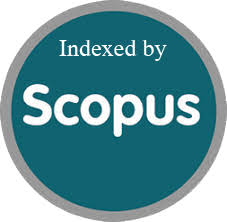A Review on Metamaterial Used in Antennas Design: Advantages and Challenges
Abstract
Metamaterial (MTM) is an artificial structure with electromagnetic specifications that are not available in materials naturally, as it acquires its distinctive characteristics from its shape. For this reason, this material has garnered great interest from researchers in the field of microwave components. In order to get around the restrictions and enhance the performance of antennas, MTM is also used in antennas. The 5G applications aspire to high gain and to provide acceptable performance, which gets attention to the necessity protection the human body from radiation. Metamaterial (MTM) provides surface waves suppression, in-phase reflection, and high impedance. This review paper addressed MTM in terms of its electrical analysis, simulation analysis, and internal structure of the unit cell to demonstrate its impact on the performance of the antenna. In addition to that, an overview of the strengths and weaknesses points of MTM characteristics have involved. Furthermore, the details about many applications like; Specific Absorption Rate (SAR) reduction, isolation, enhancing gain, miniaturization, reflector, and Artificial Magnetic Conductors AMC have been demonstrated to guide antenna designers to have an obvious picture of this material.
References
- A. Abdelaziz and E. K. I. Hamad, Isolation enhancement of 5G multiple-input multiple-output microstrip patch antenna using metamaterials and the theory of characteristic modes, Int. J. RF Microw. Comput. Eng., vol. 30, no. 11, 2020, doi: 10.1002/mmce.22416.
- A. D. Tadesse, O. P. Acharya, and S. Sahu, Application of metamaterials for performance enhancement of planar antennas: A review, International Journal of RF and Microwave Computer-Aided Engineering, vol. 30, no. 5. 2020. doi: 10.1002/mmce.22154.
- A. Gaur and S. K. Pathak, Analytical and numerical study of leaky mode characteristics of DNG metamaterial-based coaxial waveguide from GHz to THz frequency range, Opt. Quantum Electron., vol. 54, no. 3, 2022, doi: 10.1007/s11082-022-03534-w.
- A. M. Siddiky et al., Body-Centered Double-Square Split-Ring Enclosed Nested Meander-Line-Shaped Metamaterial-Loaded Microstrip-Based Resonator for Sensing Applications, Materials (Basel)., vol. 15, no. 18, 2022, doi: 10.3390/ma15186186.
- B. Asi and F. Mohmood, Beam TrackingChannel for Millimeter-Wave CommunicationSystem Using Least Mean Square Algorithm,Al-Rafidain Engineering Journal (AREJ),2021, doi: 10.33899/rengj.2021.129143.1076.
- B. K. Ledimo, P. Moaro, R. Ramogomana, M. Mosalaosi, and B. Basutli, Design Procedure of a Frequency Reconfigurable Metasurface Antenna at mmWave Band, Telecom, vol. 3, no. 2, pp. 379395, 2022, doi: 10.3390/telecom3020020.
- C. Caloz, Perspectives on EM metamaterials, Materials Today, vol. 12, no. 3. pp. 1220, 2009. doi: 10.1016/S1369-7021(09)70071-9.
- C. Milias et al., Metamaterial-Inspired Antennas: A Review of the State of the Art and Future Design Challenges, IEEE Access, vol. 9, no. June, pp. 8984689865, 2021, doi: 10.1109/ACCESS.2021.3091479.
- D. A. Sehrai, F. Muhammad, S. H. Kiani, Z. H. Abbas, M. Tufail, and S. Kim, Gain-enhanced metamaterial based antenna for 5G communication standards, Comput. Mater. Contin., vol. 64, no. 3, pp. 15871599, 2020, doi: 10.32604/cmc.2020.011057.
- D. Borges, P. Montezuma, R. Dinis, and M. Beko, Massive mimo techniques for 5g and beyondopportunities and challenges, Electronics (Switzerland), vol. 10, no. 14. 2021. doi: 10.3390/electronics10141667.
- D. K. Janapala, M. Nesasudha, T. M. Neebha, and R. Kumar, Specific absorption rate reduction using metasurface unit cell for flexible polydimethylsiloxane antenna for 2.4 GHz wearable applications, Int. J. RF Microw. Comput. Eng., vol. 29, no. 9, 2019, doi: 10.1002/mmce.21835.
- D. Yessar E. Mohammed Ali and A. J. Abdul Qader, Design of Dual Band Circular Polarization Stacked Microstrip Antenna for GPS Applications, Al-Rafidain Engineering Journal (AREJ), vol. 22, no. 3, pp. 225232, 2014, doi: 10.33899/rengj.2014.88215.
- F. Bin Ashraf, T. Alam, S. Kibria, and M. T. Islam, A compact meander line elliptic split ring resonator based metamaterial for electromagnetic shielding, Mater. Express, vol. 8, no. 2, pp. 133140, 2018, doi: 10.1166/mex.2018.1419.
- F. Tariq, M. R. A. Khandaker, K. K. Wong, M. A. Imran, M. Bennis, and M. Debbah, A Speculative Study on 6G, IEEE Wirel. Commun., vol. 27, no. 4, pp. 118125, 2020, doi: 10.1109/MWC.001.1900488.
- G. Ziegelberger et al., Guidelines for limiting exposure to electromagnetic fields (100 kHz to 300 GHz), Health Phys., vol. 118, no. 5, pp. 483524, 2020, doi: 10.1097/HP.0000000000001210.
- H. H. Tran, N. Nguyen-Trong, and H. C. Park, A compact dual circularly polarized antenna with wideband operation and high isolation, IEEE Access, vol. 8, pp. 182959182965, 2020, doi: 10.1109/ACCESS.2020.3022845.
- H. J. Jun, J. Lee, S. Choi, and Y. B. Park, Design and Fabrication of VHF Band Small Antenna Using Composite Right/Left-Handed Transmission Lines, J. Electr. Eng. Technol., vol. 14, no. 1, pp. 339345, 2019, doi: 10.1007/s42835-018-00033-5.
- I. Rosaline, A triple-band antenna with a metamaterial slab for gain enhancement and specific absorption rate (Sar) reduction, Prog. Electromagn. Res. C, 2021, doi: 10.2528/PIERC20122202.
- IEEE, IEEE Standard for Safety Levels With Respect to Human Exposure to Radio Frequency Electromagnetic Fields, 3 kHz to 300 GHz, vol. 2005, no. April. 2006.
- K. Hossain et al., ENG and NZRI Characteristics of Decagonal-Shaped Metamaterial for Wearable Applications, in 2020 International Conference on UK-ChinaEmerging Technologies, UCET 2020, 2020. doi: 10.1109/UCET51115.2020.9205409.
- K. K. R. Et. al., Design and Analysis of Metamaterial based-check board AMC Backed EBG Antenna for Body Placement Applications, Inf. Technol. Ind., vol. 9, no. 2, pp. 707721, 2021, doi: 10.17762/itii.v9i2.404.
- M. J. Alam and S. I. Latif, Double-Split Rectangular Dual-Ring DNG Metamaterial for 5G Millimeter Wave Applications, Electron., vol. 12, no. 1, 2023, doi: 10.3390/electronics12010174.
- M. Li and S. Cheung, A Novel Calculation-Based Parasitic Decoupling Technique for Increasing Isolation in Multiple-Element MIMO Antenna Arrays, IEEE Trans. Veh. Technol., vol. 70, no. 1, pp. 446458, 2021, doi: 10.1109/TVT.2020.3045231.
- M. M. Hossain, M. J. Alam, and S. I. Latif, Orthogonal Printed Microstrip Antenna Arrays for 5G Millimeter-Wave Applications, Micromachines, vol. 13, no. 1, 2022, doi: 10.3390/mi13010053.
- M. Singh, N. Kumar, P. Kala, and S. Dwari, A compact short ended dual band metamaterial antenna loaded with hexagonal ring resonators, AEU - Int. J. Electron. Commun., 2021, doi: 10.1016/j.aeue.2021.153731.
- M. Z. Mahmud, M. T. Islam, N. Misran, M. J. Singh, and K. Mat, A negative index metamaterial to enhance the performance of miniaturized UWB antenna for microwave imaging applications, Appl. Sci., vol. 7, no. 11, 2017, doi: 10.3390/app7111149.
- N. Khalili Palandi, N. Nozhat, and R. Basiri, Design and fabrication of small and low profile microstrip monopole antenna using CRLH-TL structures, J. Electromagn. Waves Appl., vol. 33, no. 13, pp. 17491763, 2019, doi: 10.1080/09205071.2019.1637285.
- N. S. Murthy, Improved isolation metamaterial inspired MM-wave mimo dielectric resonator antenna for 5G application, Prog. Electromagn. Res. C, vol. 100, pp. 247261, 2020, doi: 10.2528/PIERC19112603.
- O. Borazjani, M. Naser-Moghadasi, J. Rashed-Mohassel, and R. A. Sadeghzadeh, Design and fabrication of a new high gain multilayer negative refractive index metamaterial antenna for X-band applications, Int. J. RF Microw. Comput. Eng., 2020, doi: 10.1002/mmce.22284.
- P. Garg and P. Jain, Isolation Improvement of MIMO Antenna Using a Novel Flower Shaped Metamaterial Absorber at 5.5 GHz WiMAX Band, IEEE Trans. Circuits Syst. II Express Briefs, 2020, doi: 10.1109/TCSII.2019.2925148.
- Rajni and A. Marwaha, An accurate approach of mathematical modeling of SRR and SR for metamaterials, J. Eng. Sci. Technol. Rev., vol. 9, no. 6, pp. 8286, 2016, doi: 10.25103/jestr.096.11.
- S. Abdullah, F. Mohmood, and Y. E. Ali,Study of the Impact of Antenna SelectionAlgorithms of Massive MIMO on Capacityand Energy Efficiency In 5G CommunicationSystems, Al-Rafidain Engineering Journal(AREJ), 2021, doi:10.33899/rengj.2021.130499.1110.
- S. Agarwal and Y. K. Prajapati, Metamaterial based sucrose detection sensor using transmission spectroscopy, Optik (Stuttg)., vol. 205, 2020, doi: 10.1016/j.ijleo.2020.164276.
- S. Hannan, M. T. Islam, M. S. Soliman, M. R. I. Faruque, N. Misran, and M. S. Islam, A co-polarization-insensitive metamaterial absorber for 5G n78 mobile devices at 3.5 GHz to reduce the specific absorption rate, Sci. Rep., vol. 12, no. 1, pp. 114, 2022, doi: 10.1038/s41598-022-15221-7.
- S. Hannan, M. T. Islam, N. M. Sahar, K. Mat, M. E. H. Chowdhury, and H. Rmili, Modified-Segmented Split-Ring Based Polarization and Angle-Insensitive Multi-Band Metamaterial Absorber for X, Ku and K Band Applications, IEEE Access, vol. 8, pp. 144051144063, 2020, doi: 10.1109/ACCESS.2020.3013011.
- T. Ramachandran, M. R. I. Faruque, and E. Ahamed, Composite circular split ring resonator (CSRR)-based left-handed metamaterial for C- and Ku-band application, Results Phys., vol. 14, 2019, doi: 10.1016/j.rinp.2019.102435.
- T. Ramachandran, M. R. I. Faruque, and M. T. Islam, A dual band left-handed metamaterial-enabled design for satellite applications, Results Phys., vol. 16, 2020, doi: 10.1016/j.rinp.2020.102942.
- T. Ramachandran, M. R. I. Faruque, and M. T.Islam, Specific absorption rate reduction forsub-6 frequency range using polarizationdependent metamaterial with high effective medium ratio, Sci. Rep., vol. 12, no. 1, pp. 118, 2022, doi: 10.1038/s41598-022-05851-2.
- T. Shi, M. C. Tang, Z. Wu, H. X. Xu, and R. W. Ziolkowski, Improved signal-to-noise ratio, bandwidth-enhanced electrically small antenna augmented with internal non-foster elements, IEEE Trans. Antennas Propag., vol. 67, no. 4, pp. 27632768, 2019, doi: 10.1109/TAP.2019.2894331.
- X. Jia and X. Wang, Optical fishnet metamaterial with negative, zero, positive refractive index and nearly perfect absorption behavior at different frequencies, Optik (Stuttg)., vol. 182, pp. 464468, 2019, doi: 10.1016/j.ijleo.2019.01.066.
- X. Lei, S. Huo, M. Wang, Y. Li, and E. Li, A Compact Ultra-Wideband Polarization-Insensitive Metamaterial Absorber at 5G Millimeter Wave Band, in 2020 IEEE MTT-S International Conference on Numerical Electromagnetic and Multiphysics Modeling and Optimization, NEMO 2020, 2020. doi: 10.1109/NEMO49486.2020.9343462.
- Y. Cheng, H. Luo, and F. Chen, Broadband metamaterial microwave absorber based on asymmetric sectional resonator structures, J. Appl. Phys., vol. 127, no. 21, 2020, doi: 10.1063/5.0002931.
- Y. M. Zhang, S. Zhang, J. L. Li, and G. F. Pedersen, A Transmission-Line-Based Decoupling Method for MIMO Antenna Arrays, IEEE Trans. Antennas Propag., vol. 67, no. 5, pp. 31173131, 2019, doi: 10.1109/TAP.2019.2900406.








